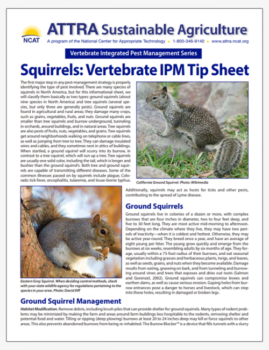Squirrels: Vertebrate IPM Tip Sheet
Vertebrate Integrated Pest Management Series
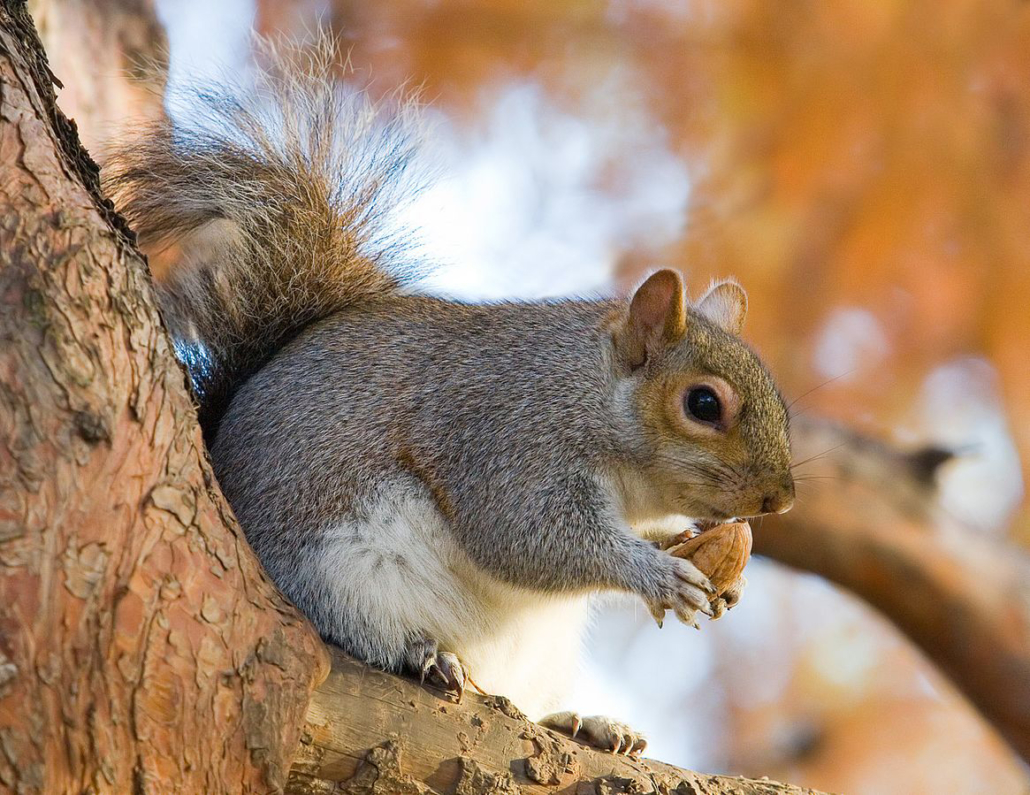
Eastern Grey Squirrel. When deciding control methods, check with your state wildlife agency for regulations pertaining to the species in your area. Photo: David Ilif
By Martin Guerena, NCAT Agriculture Specialist
Introduction
The first major step in any pest-management strategy is properly identifying the type of pest involved. There are many species of squirrels in North America, but for this informational sheet we will classify them basically as two types: ground squirrels (about nine species in North America) and tree squirrels (several species, but only three are generally pests). Ground squirrels are found in agricultural and rural areas; they damage many crops, such as grains, vegetables, fruits, and nuts. Ground squirrels are smaller than tree squirrels and burrow underground, tunneling in orchards, around buildings, and in natural areas. Tree squirrels are also pests of fruits, nuts, vegetables, and grains. Tree squirrels get around neighborhoods walking on telephone or cable lines, as well as jumping from tree to tree. They can damage insulated wires and cables, and they sometimes nest in attics of buildings.
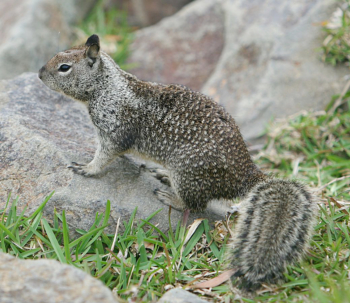
California Ground Squirrel. Photo: Wikimedia
When startled, a ground squirrel will scurry into its burrow, in contrast to a tree squirrel, which will run up a tree. Tree squirrels are usually one solid color, including the tail, which is longer and bushier than the ground squirrel’s. Both tree and ground squirrels are capable of transmitting different diseases. Some of the common illnesses passed on by squirrels include plague, Colorado tick fever, encephalitis, tularemia, and louse-borne typhus. Additionally, squirrels may act as hosts for ticks and other pests, contributing to the spread of Lyme disease. When deciding control methods, check with your state wildlife agency for regulations pertaining to the species in your area.
Ground Squirrels

This corner of a cornfield shows damage from ground squirrels, which burrow in a bank behind the photographer. Photo: Rex Dufour, NCAT
Ground squirrels live in colonies of a dozen or more, with complex burrows that are four inches in diameter, two to four feet deep, and five to 30 feet long. They are most active mid-morning to afternoon. Depending on the climate where they live, they may have two periods of inactivity—when it is coldest and hottest. Otherwise, they may be active year-round. They breed once a year, and have an average of eight young per litter. The young grow quickly and emerge from the burrows at six weeks, resembling adults by six months of age. They forage, usually within a 75-foot radius of their burrows, and eat seasonal vegetation including grasses and herbaceous plants, twigs, and leaves, as well as seeds, grains, and nuts when they become available.

This photo was taken three months later at the same location. Weeds have infested the area where the corn crop was grazed by ground squirrels, creating a potentially ongoing problem for the farmer. Photo: Rex Dufour, NCAT
Damage results from eating, gnawing on bark, and from tunneling and burrowing around vines and trees that exposes and dries out roots (Salmon and Gorenzel, 2002). Ground squirrels can compromise levees and earthen dams, as well as cause serious erosion. Gaping holes from burrow entrances pose a danger to horses and livestock, which can step into these holes, resulting in damaged or broken legs.
Ground Squirrel Management
Habitat Modification. Remove debris, including brush piles that can provide shelter for ground squirrels. Many types of rodent problems may be minimized by making the farm and areas around farm buildings less hospitable to the rodents, removing shelter and potential food and water. Tilling or ripping (deep plowing) burrows at least 20 to 24 inches deep may kill or force squirrels to other areas. This also prevents abandoned burrows from being re-inhabited. The Burrow Blocker™ is a device that fills tunnels with a slurry of sand and water. The water seeps into the ground, leaving the sand to fill the burrows. This is a new entry into the market, and its effectiveness has not been researched other than through testimonials. See Resources section for contact information. Installation of temporary or permanent visual barrier, such as opaque fencing, can deter squirrel movement and burrowing by limiting their ability to view their environment and check for predators. This technique has been successful in keeping squirrels out of Moffett Airfield in Palo Alto, California. Alternatively, flooding can force squirrels out of their burrows, but surrounding areas must be monitored and managed to prevent the squirrels from returning.
Baiting. Using toxic baits can pose threats to wildlife, pets, and children, so they should be used with extreme caution. Baits accepted in certified organic production will be mentioned in this publication. For conventional baits, such as strychnine and anticoagulants, consult your local Extension websites for guidance, and always read the label of all pesticides.
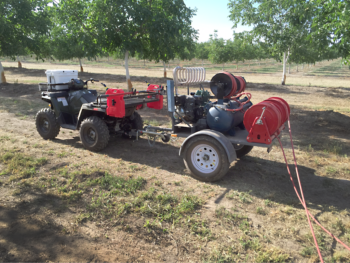
Pressurized Exhaust Rodent Controller. Photo: Perry’s Wildlife Control
Fumigation. Fumigation with smoke or gas in the burrow can be effective when sufficient soil moisture is present. Soils with high moisture prevent the gas from seeping out, as opposed to drier soils with more air space. A device called Pressurized Exhaust Rodent Controller (PERC) has shown some promise. Exhaust (2.5% carbon monoxide, CO) is captured off a gas engine that drives a compressor. It is cooled, pressurized, and injected through multiple injector hoses into the burrow of a rodent. The breathable air in the burrow is purged very rapidly. The rodent is engulfed almost immediately in a high concentration of CO gas and overcome before it has a chance to escape or block the burrow. This method is prohibited in organic production. Other fumigants used for ground squirrels include aluminum phosphide tablets or pellets and gas cartridges. Aluminum phosphide is highly toxic and a restricted material, meaning only professional applicators are allowed to use it. Sulfur dioxide gas cartridges, on the other hand, are not restricted and are widely available. Cartridges are ignited and placed in the burrow. Entrances are sealed with soil; check for escaping smoke and other openings. This method is relatively slow in filling the burrow, potentially giving time for the squirrel to escape or block off the tunnels.
Explosive devices such as the “Rodenator” eliminate most species of burrowing pests by delivering a precisely measured mixture of propane and oxygen into tunnels or burrows and detonating it, causing an underground explosion that eliminates the burrowing pest and, in some cases, collapses the tunnel structure, preventing re-infestation. This control method is hazardous and requires caution, especially in dry areas. These propane devices are not allowed in organic production.
Trapping. Trapping is an effective method of control for small areas or light infestations. There are two types of traps for squirrels: live traps and kill traps. Live trapping may involve euthanizing the animals once caught, because some states prohibit the relocation of squirrels to other areas. Even in areas where relocation is allowed, it exposes the animal to exposure, starvation, or predation. As it tries to return to its territory, it encounters other colonies that will not accept the newcomer and try to drive it away.
Kill traps include body-gripping traps, box traps, and tunnel traps. Body-gripping or Conibear traps are placed over the holes of all the entrances to the burrow system. Staking the traps is advisable to prevent the animals from taking them down into the burrow or to prevent scavengers from dragging them away. Box and tunnel traps use bait to lure the squirrels, and are placed near their burrow or runway. It is advised to place baited, unset traps for several days and, once the squirrels become accustomed to the traps, set them.
Tree Squirrels
Tree Squirrels in North America include the eastern gray (Sciurus carolinensis), western gray (Sciurus griseus), fox (Sciurus nigerS), and tassel-eared (Sciurus aberti) squirrels. There are two species of pine squirrels: the red squirrel (Tamiasciurus hudsonicus) and Douglas pine squirrel (Tamiasciurus douglasii), as well as the southern flying squirrel (Glaucomys volans) and the northern flying squirrel (Glaucomys sabrinus). All of these can damage buildings, invade attics, dig up gardens, gnaw on electrical and irrigation lines, carry fleas, mites and diseases, and feed on a variety of fruits, nuts, and other crops and plants.
Tree Squirrel Control Methods
Exclusion. Close openings to buildings and dwellings with wire mesh. Prevent squirrels from climbing poles and trees with metal collars. For trees, attach the loose-fitting metal collars with springs to allow for tree growth.
Habitat Manipulation. Tree branches should be trimmed at least eight feet away from buildings and other trees to prevent squirrels from jumping to roofs or other trees.
Trapping. As with ground squirrels, live and kill traps are options. With live traps, the squirrels will need to be euthanized and relocation may be illegal. Kill traps such as box traps and body-gripping traps can be fastened to branches with bait on the trigger and at the entrance of the trap to entice the squirrel to go in. Pre-baiting before setting the triggers may increase the trap’s effectiveness.
Control Methods Used on Both Ground and Tree Squirrels
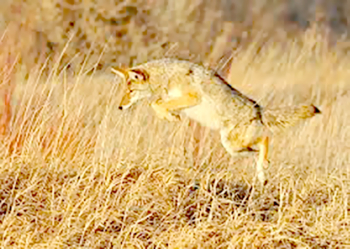
Pouncing coyote. Photo: Tom Koerner, U.S. Fish and Wildlife Service
Predators and Natural Control. Depending on the wildlife that lives in your region, many types of predators may be able to help reduce rodent populations. A healthy population of wild predators may include bobcats, foxes, coyotes, badgers, skunks, weasels, snakes, owls, ravens, hawks, and most other large birds of prey. Insert leaping coyote pic Predation accounts for a large proportion of ground squirrel mortalities, though it will not completely control a population. It is, nonetheless, worthwhile to encourage predation—especially through the use of raptor (hawk and owl) platforms, nest boxes, and perches near ground squirrel burrows. Research has demonstrated that by attracting raptors to agricultural areas, pesticide use decreases (Lindell et al., 2018; Novak and Torfeh, 2017). USDA’s Natural Resources Conservation Service (NRCS) has funding to help farmers install wildlife structures on their land, as well as funding for many other conservation practices. Your local USDA Service Center can be located here.
Shooting. Check with your local authorities to find out if discharging a firearm in and around an area is legal. Air rifles may get around this if there are restriction. Shooting in combination with other integrated pest management methods can be effective in keeping the squirrel population down.
| Summary of Squirrel Control Methods | |
| Control Methods | Allowed in Organic Production |
| Habitat Manipulation | |
| Cultivation (Ripping-Tilling) | YES |
| Burrow Blocker | YES |
| Visual Barrier | YES |
| Flooding | YES |
| Exclusion | YES |
| Baiting | |
| Strychnine and Anticoagulants | NO |
| Fumigation | |
| Pressurized Exhaust Rodent Controller (PERC) | NO |
| Smoke Cartridges (sulfur dioxide or aluminum phosphide) | NO |
| Explosive devices (“Rodenator”) | NO |
| Trapping | YES |
| Predators and Natural Controls | YES |
| Shooting | YES |
References
Lindell, C., R.A. Eaton, P.H. Howard, S.M. Roels, and M.E. Shave. 2018. Enhancing agricultural landscapes to increase crop pest reduction by vertebrates. Agriculture, Ecosystems and Environment. April 1. p 1-11.
Novak, K. and D. Torfeh. 2017. Raptor Pilot Study for Levee Protection. Ventura County Public Works Agency Watershed Protection District.
Salmon, T. P., and W. P. Gorenzel. 2002. Ground Squirrel. Pest Notes, University of California, Agriculture and Natural Resources. Publication 7438.
Further Resources
The Barn Owl. No date. By V.J. Ketner. Western Regional Office of the National Audubon Society.
How to Keep Squirrels Away from Your Garden. 2018. By The Old Farmer’s Almanac.
How to Keep Squirrels Out of Fruit Trees. 2017. By Dinesh Kumar. August 25.
Raptor Perches. No date. By Bio-Diversity Products.
Rodent-Proof Construction and Exclusion Methods. 1994. By Rex O. Baker, Gerald R. Bodman, and Robert M. Timm. p. B-137–B-150. In: Prevention and Control of Wildlife Damage—1994. Cooperative Extension, University of Nebraska, Lincoln.
Squirrels: Vertebrate IPM Tip Sheet
By Martin Guerena, NCAT Agriculture Specialist • Published June 2018 ©NCAT
IP558 • Slot 582
This publication is produced by the National Center for Appropriate Technology through the ATTRA Sustainable Agriculture program, under a cooperative agreement with USDA Rural Development. This publication was also made possible in part by funding from the National Institute of Food and Agriculture, U.S. Department of Agriculture, award number 2013-51106-20970. ATTRA.NCAT.ORG.

